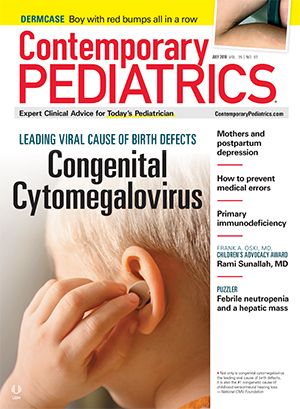Boy with red bumps all in a row
The worried mother of an 11-year-old boy arrives at the office for evaluation of an asymptomatic bumpy rash that appeared suddenly in his right groin a month ago, and that has now extended all the way down to his right ankle. What's the diagnosis?
The case
The worried mother of an 11-year-old boy arrives at the office for evaluation of an asymptomatic bumpy rash that appeared suddenly in his right groin a month ago, and that has now extended all the way down to his right ankle.
Diagnosis: Lichen striatus
Clinical presentation and epidemiology
Lichen striatus (LS) is an uncommon, benign, self-limited papular eruption that follows the lines of Blaschko. It is a condition found most commonly in young children and that favors females.1,2 Three morphological patterns are described: typical lichen striatus, lichen striatus albus, and nail lichen striatus.1
Nail lichen striatus is the least common. It occurs almost exclusively in children, and is usually restricted to a single nail.3 Lichen striatus albus is characterized by hypopigmented lesions. By far the most common morphology is typical lichen striatus, in which crops of tiny 1- to 2-mm scaly erythematous or flesh-colored flat-topped papules appear abruptly without any known trigger. The lesions are usually solitary and unilateral and most commonly involve the limbs.4 The patient is typically asymptomatic, but a minority may complain of pruritus.1 The eruption reaches maximum development over a few weeks and then self-resolves in 6 to 24 months. The only long-term sequela is postinflammatory hypopigmentation, which is seen more commonly in dark-complexioned individuals.1,2
Etiology
Although viral infections, trauma, hypersensitivity reactions, vaccines, medications, and pregnancy have been suggested as precipitators of LS, in the majority of patients triggering or causal factors are never found.2 It is thought that genetics and the environment contribute to the pathogenesis. The prevailing hypothesis is that genetic mosaicism provides the underlying substrate of LS.3 Early in development, a somatic mutation predisposes certain keratinocyte lineages to a currently unknown environmental insult. Basal keratinocytes present antigens from these unidentified environmental triggers to CD8+ T cells, leading to autoimmunity.5 Additional support for a genetic component comes from the fact that up to 85% of patients have a personal or family history of atopy.1
Differential diagnosis
In young children presenting with abrupt onset of erythematous papules in a Blaschkoid distribution, other linear lichenoid eruptions must be considered, such as linear lichen planus, lichenoid nitidus, lichenoid spinulosis, Gianotti-Crosti syndrome, chronic graft-versus-host disease, and frictional lichenoid eruption.3 The absence of pruritus, koebnerization, oral lesions, and systemic manifestations and the presence of postinflammatory hypopigmentation and nail dystrophy favor the diagnosis of LS.
Diagnosis is clinical, and biopsy is usually not necessary because LS is self-limited and histopathology is nonspecific with features of both eczema and lichen planus.6 However, for lesions that persist for longer than a year, a skin biopsy may be performed to differentiate LS from inflammatory linear epidermal nevi.7 This is important because one-third of patients with epidermal nevi have involvement of other organ systems, and there is a slight risk of malignant transformation.8 The classic biopsy finding in LS is a perivascular inflammatory infiltrate that is superficial and deep.7
Management
Because of the high likelihood of spontaneous regression, therapy is not required. The benign course of this dermatosis should be stressed to the parents. If treatment is desired because of pruritus or cosmesis, topical corticosteroids may be used. Some studies have shown these treatments hasten resolution, but this finding has not been consistently borne out.1,3
Patient outcome
A clinical diagnosis was made in this patient’s case with no further workup required. The family was reassured by the natural history of the illness. At a 6-month follow-up, the boy’s lesions had disappeared with only residual hypopigmentation.
Disclosures:
1. Patrizi A, Neri I, Fiorentini C, Bond A, Ricci G. Lichen striatus: clinical and laboratory features of 115 children. Pediatr Dermatol. 2004;21(3):197-204.
2. Peramiquel L, Baselga E, Dalmau J, Roé E, del Mar Campos M, Alomar A. Lichen striatus: clinical and epidemiological review of 23 cases. Eur J Pediatr. 2006;165(4):267-269.
3. Tilly JJ, Drolet BA, Esterly NB. Lichenoid eruptions in children. J Am Acad Dermatol. 2004;51(4):606-624.
4. Cohen BA, Davis HW, Gehris RP. Dermatology. In: Zitelli BJ, McIntire SC, Nowalk AJ. Zitelli and Davis’ Atlas of Pediatric Physical Diagnosis. 6th ed. Philadelphia, PA: Elsevier Saunders; 2012:299-368.
5. Pickert A. Concise review of lichen planus and lichenoid dermatoses. Cutis. 2012;90(3):E1-E3.
6. Moss C. Mosaicism and linear lesions. In: Bolognia JL, Jorizzo JL, Schaffer JV, eds. Dermatology. 3rd ed. Elsevier Saunders; 2012:ch 62, 943-962.
7. Goyal S, Cohen BA. Pathological case of the month. Lichen striatus. Arch Pediatr Adolesc Med. 2001;155(2):197-198.
8. Weinberg JM. Epidermal nevi. In: Lebwohl MG, Heymann WR, Berth-Jones J, Coulson I. Treatment of Skin Disease: Comprehensive Therapeutic Strategies. 4th ed. Elsevier Saunders; 2014:204-207.

Recognize & Refer: Hemangiomas in pediatrics
July 17th 2019Contemporary Pediatrics sits down exclusively with Sheila Fallon Friedlander, MD, a professor dermatology and pediatrics, to discuss the one key condition for which she believes community pediatricians should be especially aware-hemangiomas.